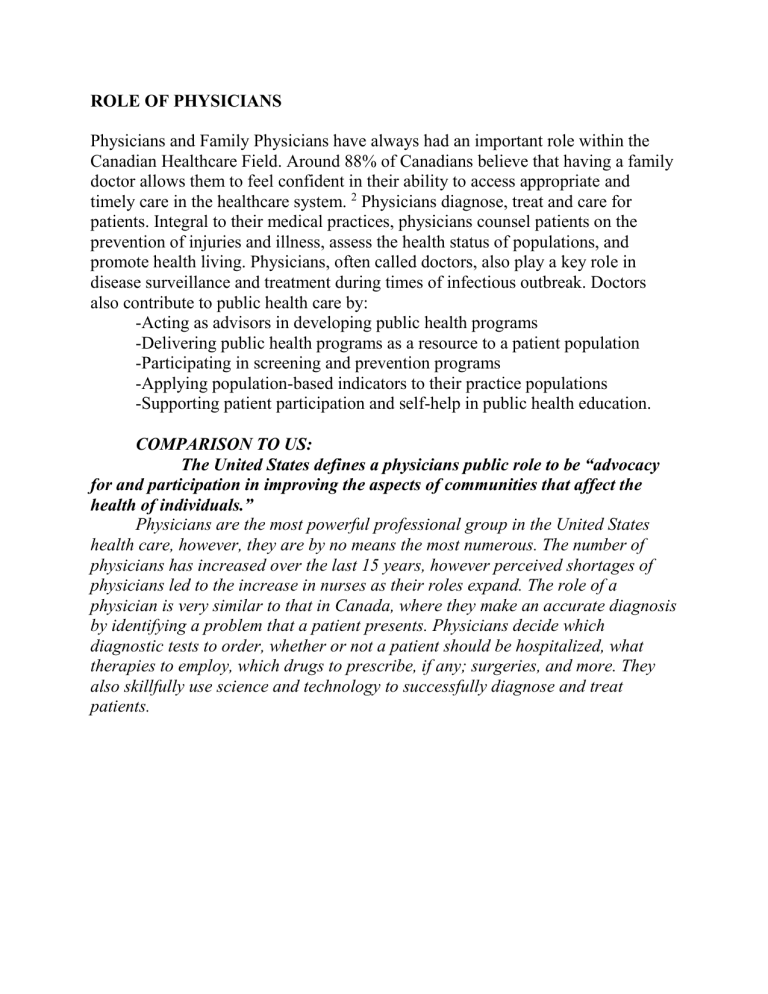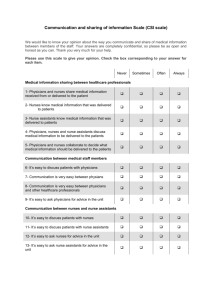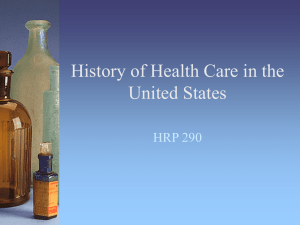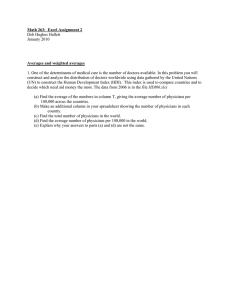Healthcare Roles in Canada & US: Physicians, Nurses, PTs
advertisement

ROLE OF PHYSICIANS Physicians and Family Physicians have always had an important role within the Canadian Healthcare Field. Around 88% of Canadians believe that having a family doctor allows them to feel confident in their ability to access appropriate and timely care in the healthcare system. 2 Physicians diagnose, treat and care for patients. Integral to their medical practices, physicians counsel patients on the prevention of injuries and illness, assess the health status of populations, and promote health living. Physicians, often called doctors, also play a key role in disease surveillance and treatment during times of infectious outbreak. Doctors also contribute to public health care by: -Acting as advisors in developing public health programs -Delivering public health programs as a resource to a patient population -Participating in screening and prevention programs -Applying population-based indicators to their practice populations -Supporting patient participation and self-help in public health education. COMPARISON TO US: The United States defines a physicians public role to be “advocacy for and participation in improving the aspects of communities that affect the health of individuals.” Physicians are the most powerful professional group in the United States health care, however, they are by no means the most numerous. The number of physicians has increased over the last 15 years, however perceived shortages of physicians led to the increase in nurses as their roles expand. The role of a physician is very similar to that in Canada, where they make an accurate diagnosis by identifying a problem that a patient presents. Physicians decide which diagnostic tests to order, whether or not a patient should be hospitalized, what therapies to employ, which drugs to prescribe, if any; surgeries, and more. They also skillfully use science and technology to successfully diagnose and treat patients. TABLE 13Number and Population Ratios of Physicians, United States, Selected Years 1950 to 1980 and Projections for 1990 and 2000 Year Total Doctors of Medicine (M.D.) Doctors of Osteopathy (D.O.) Professionally Active Physicians per 10,000 Population 1950 219,900 209,000 10,900 14.1 1960 251,900 239,700 12,200 13.6 1970 326,500 314,200 12,300 15.6 1980 457,500 440,400 17,100 19.7 1990 591,200 563,300 27,900 24.3 2000 704,700 665,700 39,000 27.1 SOURCE: Table 52, Reference #24. ROLE OF NURSES Advanced Practice Nurses refers to nurses with advanced educational preparation who function in expanded or extended roles in a variety of clinical practice settings. APNs include Nurses, Nurse Practitioners, and Clinical Nurse Specialists. The Nurse Practitioner role is well established in Canada, and “they function as the primary care practitioner to increase access to healthcare.”1 When needed the NP functions in diagnosing and treating health problems as well as prescribing medications. Usually this is the job of a physician, but Nurse Practitioners function as the Physician in certain settings. Most APN’s are found in acute and primary care settings in Canada, as well as long-term care facilities. In America, the majority of APNs practice in larger urban centers. In 2000, a health region located in western Canada received approximately $300,000 (Canadian Dollars) from a health ministry to implement and evaluate new nursing initiatives. The purpose of the sponsorship was to explore opportunities for nurses to practice in expanded roles, such as that of a PA or Physician, to improve healthcare of older persons in the rural settings of Canada. IN COMPARISON TO THE US: Nurses play a greater role in the United States than they do in the Canadian Healthcare field. The Nursing field is becoming more sought after since the cost of medical school and school debt is on the rise. The roles of Nurses are increasing, therefore, becoming more popular as it takes less time, and less money than that of a physician. Nurses are now responsible for following up with patients to provide greater resources to those with chronic conditions, monitoring conditions, and more within and beyond the hospital setting. Figure 1: Availability of primary care physicians and percentage of primary care physicians working with physician assistants or nurse practioners, by urbanicity: United States, 2012. ROLE OF PHYSICAL THERAPISTS Physical Therapists utilize diagnostic and assessment procedures and tools “in order to develop and implement preventive and therapeutic courses of intervention.” PTs focus their attention to musculoskeletal, neurological, cardiorespiratory, and multi-systems of patients. Physical Therapists also analyze the impact of disorders, injury, and disease on a persons movement and function. They work to improve, promote, restore or prolong physical independence by enhancing their functional capacity. Their roles include- but are not limited to: -Education, consultation, health promotion and prevention services, -Personalized therapeutic exercise including testing, conditioning, and other approaches to improve strength, range of motion and function. -Soft tissue and manual theraphy techniques, including massage, spinal and peripheral join mobilization and manipulation. -Cardiorespiratory techniques including airway clearance methods -Skin and Wound Care -Functional activity and tolerance testing and training. Physical Therapists work in private or public settings providing client and/or population health interventions as well as management. Settings include; Clild-development centers, community health centers, health clubs, hospices, hospitals, home care, nursing homes, occupational health centers, prisons, rehab centers, research facilities, etc. In 2005, the Ontario Medical Association conducted an opinion poll to determine Canadians perspectives on healthcare. The poll indicated that 95% of Canadians want more information on what alternatives exist to improve the quality of care. Implementation of innovative approaches to deliver the services provided opportunities to expand the roles of Physical Therapists. Within the last two decades, Canadian PT roles shifted from primarily hospital-based, to practitioners in both public and private sectors. While their roles expanded, so did their education requirements. Now, to become a PT, a master’s degree is required instead of the previous requirement baccalaureate degree. In 2010, all Canadian Universities that offered PT programs, implemented the master’s degree program. In the graph below, it indicates the ratio between different specialties within being a PT, either a Clinical Specialist PT, or Advanced Practitioner PT. References If doing paper in AMA Format: 1. Higuchi KAS, Hagen B, Brown S, Zieber MP. A new role for advanced practice nurses in Canada: bridging the gap in health services for rural older adults. Journal of Gerontological Nursing. 2006;32(7):49-55. http://libproxy.ung.edu/login?url=http://search.ebscohost.com/login.aspx?dire ct=true&db=ccm&AN=106334370&site=eds-live&scope=site. Accessed November 26, 2018. 2. College of Family Physicians of Canada. Wait Times and Access to Care Decima Poll Commissioned by the CFPC, November 2004 3. The College of Family Physicians of Canada. The role of the family doctor in public health and emergency preparedness. 2005;Dec3-16. https://www.cfpc.ca/ProjectAssets/Templates/Resource.aspx?id=1006&langType =4105 4. Canadian Physiotherapy Association. Essential Competency Profile for Physiotherapists in Canada (ACCPAP, Alliance, CPA & CCPUP, 2009) and the Entry-to- Practice Physiotherapy Curriculum: Content Guidelines for Canadian University Programs (CCPUP, CPA, Alliance & ACCPAP, 2009). 5. Yardley D, Gordon R, Freeburn R, et al. Clinical specialists and advanced practitioners in physical therapy: a survey of physical therapists and employers of physical therapists in Ontario, Canada. Physiotherapy Canada. 2008;60(3):224-238. http://libproxy.ung.edu/login?url=http://search.ebscohost.com/login.aspx?dire ct=true&db=ccm&AN=105701106&site=eds-live&scope=site. Accessed November 26, 2018. 6. Institute of Medicine (US) Division of Health Sciences Policy. Medical Education and Societal Needs: A Planning Report for the Health Professions. Washington (DC): National Academies Press (US); 1983. Chapter 4, THE PHYSICIAN'S ROLE IN A CHANGING HEALTH CARE SYSTEM. Available from: https://www.ncbi.nlm.nih.gov/books/NBK217690/




